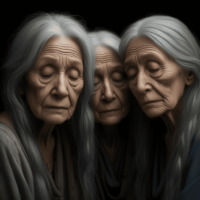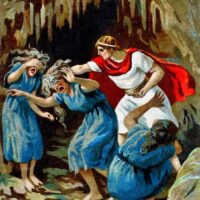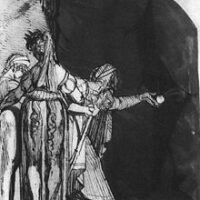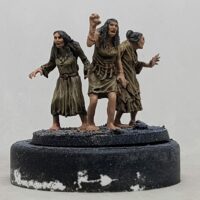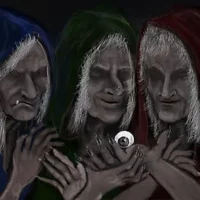Graeae : The Grey Sisters
Listen
At a glance
| Description | |
|---|---|
| Origin | Greek Mythology |
| Classification | Gods |
| Family Members | Phorcys (Father), Ceto (Mother) Medusa (Sister), Ladon , Echidna (Siblings) |
| Region | Greece |
| Associated With | Fortunetelling, Magic and Wisdom |
Graeae
Introduction
The Graeae, alternatively referred to as the Grey Sisters, stand out in the rich landscape of Greek mythology. Comprising three sisters who collectively possess a single eye and tooth, they embody wisdom, foresight, and an understanding of the unknown. These figures, often overshadowed by their more famous counterparts, the Gorgons, offer a distinct narrative within ancient lore. Their story is one of intrigue, guardianship, and a window into the depths of Greek mythological imagination. In the vast expanse of Greek mythology, the Graeae, known also as the Grey Sisters, occupy a unique niche. Neither wholly divine nor entirely mortal, they represent the essence of fate and the relentless march of time.
Physical Traits
The Graeae are distinguished by their unique physical characteristics, notably their shared eye and tooth. Depicted as elderly women, their name reflects their aged appearance. Despite their frailty, they wield considerable power and knowledge. Their singular eye grants them the ability to peer into the future, while their shared tooth symbolizes their collective wisdom. Legends portray the Graeae as three elderly sisters who collectively possess a single eye and tooth. Their appearance, marked by gray hair, weathered faces, and aged bodies, evokes an unsettling aura, embodying the mysterious essence of ancient mythological beings.
The exchange of their solitary eye and tooth underscores their interconnectedness and unity as siblings. Renowned for their grotesque visage, the Graeae earned the epithet “Grey Ones” due to their gray hair from birth. Hesiod, a prominent figure in Greek literature, depicted them with a solitary eye and tooth shared among them. Later renditions elaborated on this unsettling imagery, portraying them with wrinkled skin, stooped postures, and twisted claws. Despite their outward grotesqueness, hints of hidden beauty beneath their aged exterior suggest a past where they may have possessed a more conventional form.
Family
The Graeae trace their lineage back to the primal forces of the universe, embodying the raw essence of creation. According to Hesiod, their parents were Phorcys, a deity symbolizing the unfathomable depths of the sea, and Ceto, a monstrous goddess embodying the perils lurking beneath ocean waves. Their siblings included formidable creatures like the Gorgons, renowned for their petrifying stare, and the monstrous serpent Hydra. Together, these offspring of primordial entities epitomized the untamed chaos and primal power that reigned before the ascent of the Olympian gods. Born into a lineage of formidable sea deities, the Graeae are part of a monstrous family. Their siblings include the infamous Gorgons, among others like Ladon and Echidna. This lineage ties them to some of the most fearsome entities in Greek mythology.
Emerging from the lineage of sea deities Phorcys and Ceto, the Graeae embody the essence of primordial chaos and power. They share parentage with the Gorgons—Medusa, Stheno, and Euryale—known for their serpentine features and lethal gaze. While the Gorgons symbolize terror and destruction, the Graeae represent a different facet of ancient complexity, embodying wisdom, foresight, and the relentless passage of time. Despite their familial connection, the Graeae and the Gorgons follow distinct paths in Greek mythology, each leaving a unique mark on the narratives of gods and mortals.
Other names
The Graeae, renowned for their grotesque appearance and connection to fate, were identified by various names echoing their eerie characteristics. Referred to as the “Grey Ones” due to their perpetually gray hair, they were also dubbed the “Sharers” or the “One-Eyed Ones” because of their shared eye and tooth. Epithets like “Hag-Maidens” and “Grim Ones” accentuated their monstrous countenance. These appellations not only distinguished them but also served as constant reminders of the ceaseless passage of time and the inevitable decline awaiting mortals. Additionally, they are known as the Phorcides, denoting their paternal lineage from Phorcys. In certain texts, they go by the name of the Stygian Nymphs.
Each sister bears a distinct name: Deino (or Dread), Enyo (or Horror), and Pemphredo (or Alarm). Beyond the Graeae, these legendary figures are recognized by various names across different narratives and interpretations. Sometimes labeled as the Grey Sisters, their aged appearance and shared identity are emphasized. The epithet “Deino,” signifying dread or terror, underscores the profound impact they evoke. The diverse array of names and titles adds depth to their portrayal, highlighting their multifaceted nature within the tapestry of mythology.
Powers and Abilities
Despite lacking the overtly destructive abilities of their Gorgon kin, the Graeae wield their own formidable powers rooted in ancient wisdom and foresight. Their shared eye endows them with the ability to perceive past, present, and future, granting them knowledge coveted by both gods and mortals. This gift serves as both a boon and a burden, as they vigilantly safeguard it from those who would exploit it for personal gain. Despite their frail exterior, the Graeae command significant influence through their prophetic insights and enigmatic wisdom. Renowned for their grotesque appearance, the Graeae are imbued with a plethora of supernatural abilities. Acting as custodians of fate’s secrets, they hold sway over the past, present, and future.
Unlike the passive weavers of destiny, the Fates, the Graeae are believed to exert some control over the threads of fate, offering cryptic counsel to those who seek their guidance, albeit at a steep price. Their shared eye and tooth symbolize their interconnectedness and their grasp of a singular, unified truth. However, this dependency also renders them vulnerable, as the theft of their eye or tooth could render them powerless. At the core of their prowess lies their shared eye, bestowing upon them the gift of prophecy. As oracles, they possess the ability to foresee the unfolding of events. Additionally, they possess a degree of shape-shifting prowess, capable of assuming various animal forms. Despite their physical constraints, their unparalleled knowledge and wisdom render them formidable adversaries.
Modern Day Influence
The Graeae’s influence extends far beyond the realm of ancient mythology, permeating modern culture in literature and film. They make appearances in Rick Riordan’s “Percy Jackson & The Olympians” series, where they operate a taxi service, adding a whimsical touch to their enigmatic personas. In cinematic adaptations like the 1981 film “Clash of the Titans” and its 2010 remake, they take on the role of witches aiding the hero Perseus on his epic quest.
Their archetype as wise crones, possessing secret knowledge and mystical sight, resonates across various forms of media. From classical literature to contemporary retellings of ancient myths, references to the Graeae abound, inspiring reinterpretations and inviting audiences to explore the depths of human consciousness and the eternal dance between past, present, and future.
In popular culture, the Graeae serve as a poignant reminder of the enduring power of Greek mythology. Their presence is evident in literature, art, film, and television, where they continue to captivate audiences with their grotesque appearance and association with fate. Artists and writers draw upon their imagery to craft new narratives exploring themes of aging, prophecy, and the unseen forces that shape our destinies. Through their multifaceted portrayal, the Graeae continue to intrigue and inspire, leaving an indelible mark on the collective imagination of society.
Related Images
Frequently Asked Questions
What is lorem Ipsum?
I am text block. Click edit button to change this text. Lorem ipsum dolor sit amet, consectetur adipiscing elit. Ut elit tellus, luctus nec ullamcorper mattis, pulvinar dapibus leo.
What is lorem Ipsum?
I am text block. Click edit button to change this text. Lorem ipsum dolor sit amet, consectetur adipiscing elit. Ut elit tellus, luctus nec ullamcorper mattis, pulvinar dapibus leo.
What is lorem Ipsum?
I am text block. Click edit button to change this text. Lorem ipsum dolor sit amet, consectetur adipiscing elit. Ut elit tellus, luctus nec ullamcorper mattis, pulvinar dapibus leo.
What is lorem Ipsum?
I am text block. Click edit button to change this text. Lorem ipsum dolor sit amet, consectetur adipiscing elit. Ut elit tellus, luctus nec ullamcorper mattis, pulvinar dapibus leo.
What is lorem Ipsum?
I am text block. Click edit button to change this text. Lorem ipsum dolor sit amet, consectetur adipiscing elit. Ut elit tellus, luctus nec ullamcorper mattis, pulvinar dapibus leo.

